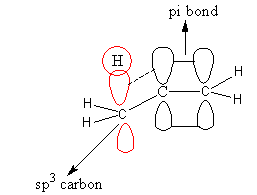Question
Question: Hyper conjugation is possible in which of the following species? A. \({\text{C}}{{\text{H}}_{\text...
Hyper conjugation is possible in which of the following species?
A. CH3−CH2 +
B. C6H5−CH3
C. CH2=CH2
D. CH3−C−(CH3)2−CH=CH2
Solution
To determine the answer we should know what hyperconjugation is. In Hyper conjugation hydrogen from an alkyl transfer to the unsaturated carbon. We will find the species in which alkyl is present nearby unsaturation.
Complete step-by-step answer:
During Hyper conjugation hydrogen of sigma bond or alkyl hydrogen transfer to the carbon having unsaturation means double or triple bond. For Hyper conjugation, two carbon having sp3and sp2 hybridization should be adjacent.
The interaction between orbitals during hyper conjugation is shown as follows:

So, we determine the species having sp3 hybridized carbon atom near to the double bond.
The given structures are as follows:
CH3−CH2 +
In the above structure unsaturation is not present so, it will not show hyper-conjugation.
C6H5−CH3
In the above structure phenyl ring have unsaturation and hence the sp2 hybridised carbon centres and it also have methyl group whose hybridization is sp3so, it will show hyper-conjugation.
The hyper-conjugation is shown as follows:

CH2=CH2
In the above species unsaturation is present but alkyl group or sp3 hybridised carbon centre with hydrogen is not present so, it will not show hyper conjugation.
D. CH3−C−(CH3)2−CH=CH2 In the above species unsaturation is present and alkyl group or sp3 hybridised carbon centre is also present it does not has any hydrogen that can transfer present so, it will not show hyper conjugation.
So, hyper conjugation is possible in C6H5−CH3species.
Therefore, option (B) C6H5−CH3is correct.
Note: The unsaturation and alkyl group are must for hybridization. During hybridization sigma bond form alkyl breaks and sigma bond with unsaturated carbon forms. The alkyl group are sp3 hybridised. Only the presence of sp3 hybridised carbon is not sufficient, the sp3 hybridised carbon should have at least one hydrogen.
